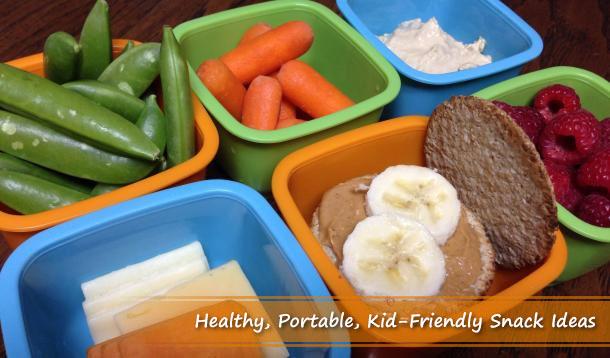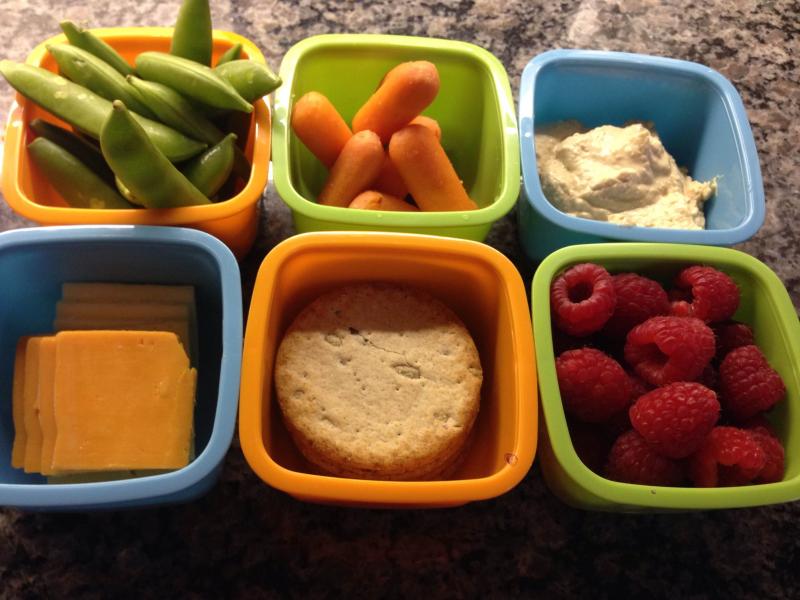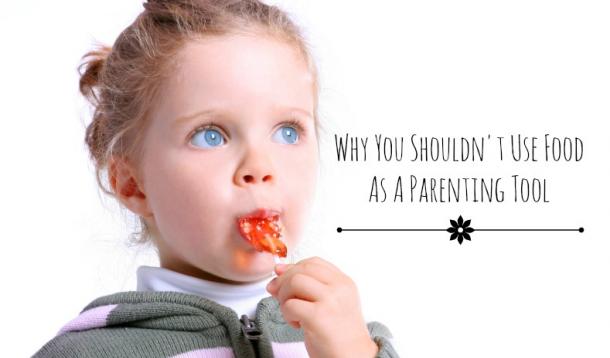
During the months leading up to conception, make sure that your body is primed to grow a healthy, thriving baby. There are a few things that you'll want to consider before trying to conceive. Reaching a comfortable and healthy weight for you, making sure that your diet is healthy and balanced for the most part, and including some enjoyable physical activity into your routine (if you haven't already) are all important goals to have in mind when you start getting "baby fever."
While improving your nutrition at ANY stage of pregnancy is great (research suggests that an expectant Mother’s eating habits directly effect her baby’s health and food preference during infancy and beyond), it’s better to start adopting healthy habits before a positive pregnancy test.
What’s most important is that you’re eating healthfully most of the time, making sure to include lean sources of protein, calcium-rich foods, whole grains, veggies and fruits in your diet (with a treat here and there, of course). But because your nutrient requirements increase during pregnancy, it’s important that you start taking a prenatal multivitamin before you become pregnant to fill any nutritional gaps. Even if you are a very healthy eater, it’s nearly impossible to meet all of your requirements with food alone. This doesn’t mean that you have to go out and spend a lot of money on expensive vitamins from the health food store. In fact, I often suggest against buying these (they tend to provide too much or too little of the important nutrients that you need during pregnancy and at times are not government regulated) and instead, opt for a good quality pre-natal multivitamin from your local pharmacy (or one that your Doctor has prescribed).
Here’s what to look for in a pre-natal multivitamin:
Folic acid is the synthetic version of folate, a B vitamin naturally found in foods like lentils, beans, and leafy greens. Because it is difficult to get enough folate naturally in your diet (especially in the first few months due to potential nausea), it's important to ensure that your multivitamin contains enough (which most do). Folic acid is extremely important to help protect your baby against neural tube defects (which turn into brain and spinal cord defects) in those first days and weeks after conception when many women are not aware that they are pregnant yet and is essential to normal development of the spine, brain and skull of the fetus. Unless you've previously had a baby with a neural tube defect, or your Doctor suggests that you take a higher dose of folic acid, what’s recommended is 400-1000 micrograms (mcg) per day.
Iron is an important mineral, especially during pregnancy, that is naturally found in meats, poultry, fish, eggs, beans, lentils, and some vegetables. It plays an important role in transporting oxygen throughout your body and it also helps to reduce your risk of pre-term birth as well as low birth weight. When you become pregnant, your iron needs triple (think about all of that extra blood that you have circulating in your body!). It’s hard to obtain this extra iron from diet alone, so what’s recommended is 16-20 mg per day (many prenatal multivitamins contain 27 mg, which is ok). If you notice that you're unusually tired and weak, you may have low iron (iron-deficiency anemia), which is not uncommon during pregnancy due to the huge increase in blood volume that occurs. Your Doctor, Dietitian, or Midwife may recommend an additional Iron supplement in this case.
Milk, yogurt and cheese are the gold standards when it comes to calcium content, but you can also obtain it from canned salmon (with the soft bones), sardines, anchovies, certain vegetables such as spinach and collard greens, almonds and molasses. It's important that you're consuming 1000 mg of calcium per day through diet and/or supplement form, not only to support your own bone health, but also to help to build strong, healthy bones and teeth for your baby. Most prenatal multivitamins only contain about 250-300 mg of calcium, therefore will not support all of your calcium needs. That why it’s important that you’re also including calcium-rich foods in your diet (about two to three servings a day).
Make sure that your multivitamin contains extra vitamin D (most contain 200-400 International Units). Vitamin D helps with calcium absorption which is essential for bone health. It also helps to prevent Rickets (which can lead to birth deformities), delays in physical development and abnormal bone growth. If you’re lacking vitamin D during pregnancy, your baby may fall short of the vitamin at birth. The Dietary Recommended Intake (DRI) of Vitamin D for pregnant and breastfeeding women in Canada is 600 IU per day (I usually recommend 1000 IUs per day though). Make sure to top up with an additional vitamin D3 supplement if your prenatal vitamin does not supply this amount and if you aren't getting enough vitamin D in your diet. You can find dietary sources of vitamin D in cow's milk, fortified milk alternatives, eggs yolks, red meat and many kinds of fish.
You also want to make sure that you’re not getting too much of any nutrient. More specifically, you don’t want to overdose on vitamin A, because it may cause birth defects in your baby. Limit your vitamin A supplementation to no more than 5000 IUs per day. Most regulated prenatal multivitamins will not exceed this amount.
Prenatal multivitamins typically do not include omega 3 fatty acids, but it's important to make sure that you're getting enough prior to and during pregnancy, as your requirements are higher. During pregnancy, omega-3 fatty acids travel through the placenta to your baby to help grow his or her brain and tissues. The best way to ensure you're getting enough, is to consume at least two standard servings (three ounces cooked is a serving) of fatty, low-mercury fish per week such as salmon, canned light flaked tuna, or trout. If you don't like fish, you should consider taking an omega-3 supplement.
Look for proof of government regulation on your prenatal multivitamin container. You should notice an NPN# or NHP# (natural health product number). This basically means that your supplement contains what it says it contains, it is in a safe dose if taken as directed and is of high quality. It also means that the supplement has also been tested for things like heavy metals (in the case of fish oil supplements), pesticides, and toxins.
If you found this post helpful, you may also want to learn what The Six Most Important Nutrients For a Healthy Pregnancy are as well as How To Manage Pregnancy-Related Digestive Issues.

Now that summer is here, my days have suddenly filled up with playdates, trips to the zoo, and long mornings at the splash park. With two active kids under the age of four, I always have to have a stash of filling snacks on hand.
Although my kids enjoy their fair share of fun "treat" foods, especially in the summer, the curse (or blessing?) of being a registered dietitian is that I am well aware of every ingredient that my kids eat. I know that most store-bought cookies or fruit snacks might keep my kids satisfied for half an hour until they become ravenous again.
The challenge, I've found as a health-conscious mom, is trying to find a balance between health and convenience when I'm on the go with my little ones. Finding portable snacks that I feel good about feeding my kids (and eating myself) can be challenging, as I'm sure many moms can attest to.
In my quest to find that balance between health, taste, and portability, I've come up with a few snack options that can also be transformed into meals. Here are some of our new go-tos:

Instead of making the same old "wrap" sandwiches, turn your whole grain tortillas into colourful and kid-friendly "sushi rolls" using different cut-up fruits, veggies and spreads. I prepare these the night before, chill them after I've rolled them up and then cut them into individual bite size sushi rolls either before leaving the house or when we've reached our destination. Be creative and don't be afraid to test out some weird and wonderful combinations. Some of our favourites are:


Instead of using bread (which often becomes soggy) to make sandwiches, try using healthy crackers, such as Nairn's Oat Crackers. Kids love crackers because they are crunchy and fun to eat, but it's hard to find crackers that aren't full of trans fats, additives and preservatives.
Nairn's oat crackers and cookies (they come in 7 yummy varieties!) are wheat free and made from organic whole grain oats, which are naturally high in soluble fibre—a fibre that allows energy to be released gradually, preventing blood sugar peaks and drops—which helps to keep kids (and adults) fuller longer and sustains energy levels longer.
What I love the most about these crackers is that they are free of added sugar, preservatives, additives, artificial colours and flavours, as well as genetically modified ingredients. I also love that they don't fall apart (they're durable!), like many crackers do, in our lunch bag.
Try making "crackerwiches" with protein-rich foods such as cheese, hummus, and nut butters as well as fresh fruits and veggies. Our favourite combinations are peanut butter and banana, strawberry jam and cheddar cheese, almond butter and raisins, and cream cheese and cucumber rounds.


For more yummy topping ideas, check out Nairn's Oatcake Recipes.
Instead of buying trail mix, make your own by combining your favourite nuts, unsweetened dried fruit, and whole grain cereal into a container or baggy to take with you in your purse, diaper bag, or lunchbag. I keep a giant container of nuts, seeds and dried fruit in our pantry, and before leaving the house, fill a baggy full and add the cereal in last minute so that it doesn't become soft. If one of your kids has a nut allergy, you could use seeds or roasted chickpeas instead. Try to choose a cereal without a lot of added sugar or preservatives. Have your kids choose their favourite combinations.

These are super easy and packed full of nutrition. Slice a whole apple into three large slices (removing the core and seeds from each slice). Layer the slices on top of one another with your choice of spreads, toppings or fillings. We usually stick cheese slices in between the first layer and natural nut butter with dried fruit in between the second layer. My son finds it easier to eat the top first and then dig in to the rest.

We often make French toast or whole grain pancakes on the weekend for breakfast and I always make sure to cook extra for snacks during the week. Cut leftover French toast or pancakes into strips and pack along with your kids' favourite dips. Our favourite dip is made up of a mixture of 1/2 cup vanilla Greek yogurt + 1 tbsp natural peanut butter and a sprinkle of cinnamon. This dip also works great for crackers and fresh fruit.

Who doesn't love finger foods? This snack (or meal) is fun for kids, easy to prepare, and easy to pack. Purchase a container with several compartments or several small containers and fill them with your kids favourite finger foods such as raisins, cheese, roasted chick peas, fresh fruit, veggie strips, healthy dips and high fibre, healthy crackers.

This is proudly sponsored by our friends at Nairn's.
www.nairns-oatcakes.com/nairns-abroad/canada

Food can be a powerful tool when it comes to parenting.
It can calm a tantruming child, it can be used to coax a child into behaving a certain way, it can create peace when confrontation arises, and it can distract a child when he has fallen and hurt himself.
As the parent of a three-and-a-half-year-old and one-year-old, I know how tempting it is to use food as a parenting tool (and I have used it before, trust me!). It is an instantaneous fix. A sigh of relief. But when we use food—something that is meant only for nourishing—to discipline, distract, reward, or bribe, it can have lasting effects on not only our kids' health, but their lifelong relationship with food.
![]() How To Use Halloween To Boost Your Child's Relationship With Food
How To Use Halloween To Boost Your Child's Relationship With Food
As parents, we often put our "short-term lens" on when it comes to feeding, especially with young kids. We are often in a rush and want our kids to eat something NOW or behave a certain way NOW, so without even thinking about it, we turn to what works—food. Maryann Jacobsen, Registered Dietitian and co-author of "Fearless Feeding" says on her blog "when we are short-term focused with feeding, we are more tempted to employ feeding strategies that are counter-productive for kids’ eating down the line." She wrote a terrific post on what rewarding with food looks like 20 years later that is definitely worth reading.
Although it can be challenging, it's extremely important that we learn to put our "long-term lens" on when it comes to feeding, as to help our children form positive core beliefs (something that YMC's Psychotherapist Andrea Nair talks about often) about food for life.
After working with kids and adults in my nutrition counseling practice; some who either have severe picky eating issues, disordered eating patterns or full blown Eating Disorders, it has become clear to me that when parents use food as a parenting tool, kids form negative associations with food. Andrea Nair agrees, and urges parents to "stick to using food as body-fuel." She says that "when food is used for things like bribes, distraction, rewards, praise or punishment, a negative association might be created between food and a particular experience. When this happens, the risk of food avoidance or food addiction goes up."
I remember standing in a grocery line recently watching a mom with a preschool-aged boy who had just fallen and scraped his knee in front of me. His mom, trying to console him (and stop the crying), reached into her purse to grab a lollipop. immediately, her son stopped crying and excitedly unwrapped his treat.
![]() Use This Fun Distraction To Keep Your Child Busy In A Waiting Room
Use This Fun Distraction To Keep Your Child Busy In A Waiting Room
We've all been there—our child enters the throes of a tantrum in public or hurts himself and screams/cries at a playground and all of a sudden all eyes are on you and your child and you're desperate to make it stop.
Distracting your child with food works short term, but it also hinders your child's ability to work through his negative feelings (Andrea Nair wrote a great three-part series on how to deal with tantrums if you'd like to check it out). It also encourages your child to turn to food as a coping mechanism. As your child grows, instead of working through tough times in a healthy way, he may turn to food for comfort or to distract himself.
When we reward a child for good behaviour with food ("you were such a good girl at Grandma's house, now you can have an ice cream cone!), a child will begin to associate food with being "good."
Most of the time, reward foods are sweet and delicious (treats), therefore, foods that are already "fun" are put on a higher pedestal and become even more desirable. Often, kids who are rewarded with food learn to use food as a comfort tool. Later in life, this may translate into late night binging after a tough day at work (or with the kids) and then subsequent dietary restriction the next day—I've seen this time and time again in my practice. Andrea Nair agrees by saying "instead of looking at food as an enjoyable way to feed hunger, children might start to associate food with making themselves feel better. These associations can be hard to break later in life."
When it comes to healthier ways to reward your kids, Andrea Nair states that "the process of using words that inspire a child to cooperate rather than tricking them to comply will grow their problem-solving skills instead of their defenses. With a calm, friendly tone, parents can teach their children to move through their big feelings without involving food."
What I've noticed with my own preschooler, is that saying "I noticed that you were sharing really well with Nate" or "I saw you protecting your baby sister there" goes much further than rewarding with something like food. It lets him know that I noticed his good behaviour and gives him a confidence boost and sense of pride, which helps to encourage the behaviour again.
I often see desperate parents who are pleading with their children to stop misbehaving by offering a treat food, or by withholding a treat food: "No dessert tonight if you keep whining" or "if you want dessert tonight, you better start listening to me."
It is most certainly a quick and easy way to get your child to behave a certain way, at least for the short term and so many well-intentioned parents do it. Bribing your child with food once in a while will likely not cause any harm, but if it happens regularly, it may have long-term consequences. It may interfere with your child's natural hunger/fullness cues, it will encourage emotional eating, it will increase your child's desire for sweet foods and it will increase your child's chances of health concerns such as overweight and obesity. Here's a post with more information about the consequences of bribing your kids with food.
This may occur less often than bribing, rewarding, or distracting, but nevertheless, it does happen. Kids, especially when they reach preschool age, may start to ask for certain foods over others (treats over healthier foods) and may even start to sneak foods if they feel as though they shouldn't be having them. More commonly, they may eat only one type of food (perhaps starchy carbohydrates) at a meal and leave the rest. If this sounds familiar, you may have unintentionally shamed your child by saying something like "your brother eats his broccoli, why don't you?" or "I'm disappointed in you for leaving all of the vegetables in your plate" or "you are not allowed to have that cookie! I've told you a million times—no sneaking food!!"
![]() Mom Publicly Shames Daughter: Is It Tough Love Or Abuse?
Mom Publicly Shames Daughter: Is It Tough Love Or Abuse?
Making your child feel ashamed for eating certain foods over others, sneaking food or not eating a certain food will not only hurt his self-esteem, but it will also create negative associations with food and perhaps encourage long-term picky eating, binge eating or other forms of disordered eating. Know that food jags (only eating one food over and over again), sneaking food, and avoiding certain foods is COMPLETELY normal. These are food phases that will pass, and it's important that we as parents support our kids through them without damaging their relationship with food. Here's a post that will help you navigate food jags, and food neophobias (refusing to eat certain foods).
When it comes to sneaking food, the key is to not react in a negative way, because if you do, your child will desire that food even more, and the sneaking will continue (and may even continue into adulthood). Instead, take a deep breath and calmly approach your child by saying something like "I see that you're enjoying some treats buddy...those look yummy. You do not have to sneak food in our house — all foods are allowed — fun foods too! But if you'd like to continue to eat your treat, you're going to have to sit at the table. You also have the choice of saving the rest for later, because this will be your treat for the day. It's up to you when you have it." Or something along those lines. When you approach it this way, you will dodge a tantrum and you will also decrease the chances of your child sneaking food again, because he knows that the food is not "forbidden."
If this was helpful, you may be interested to find out what the #1 feeding mistake that parents make is and why cereal may not be the best breakfast choice for kids
I post daily nutrition tips and resources for families over on my Facebook Page, so please feel free to check it out!